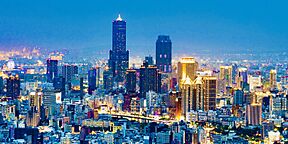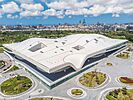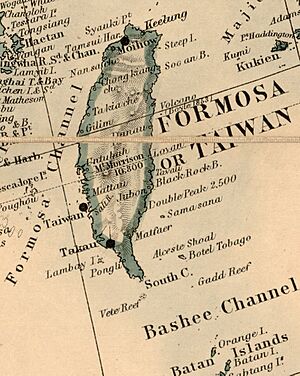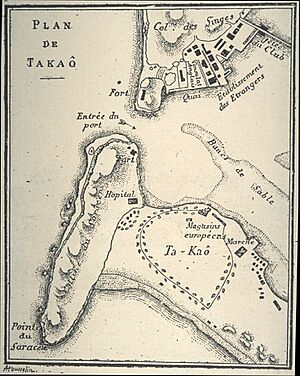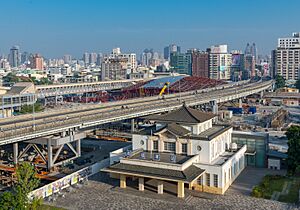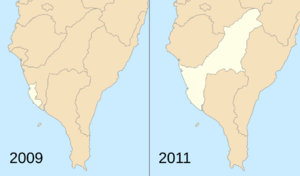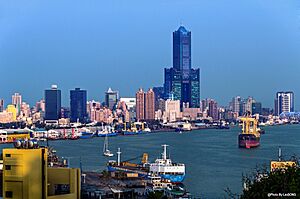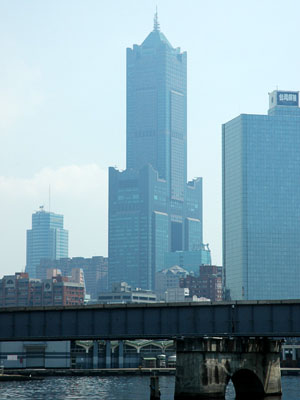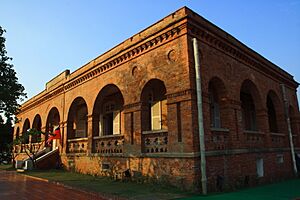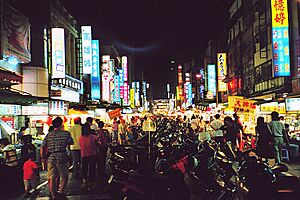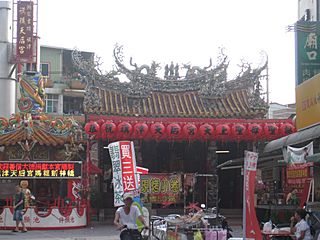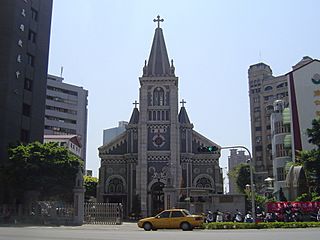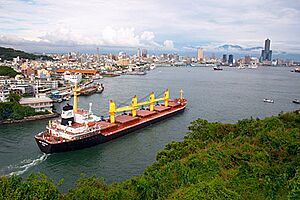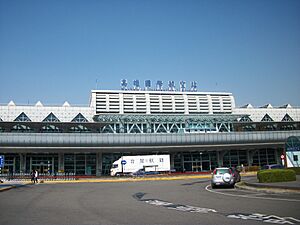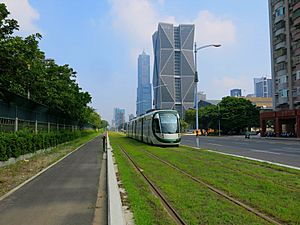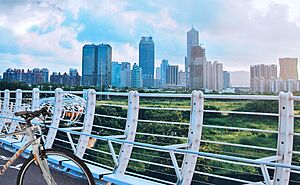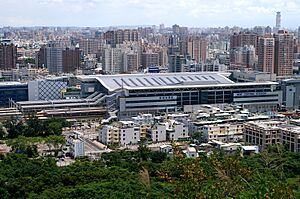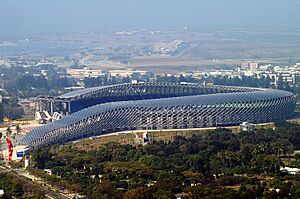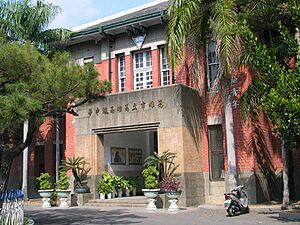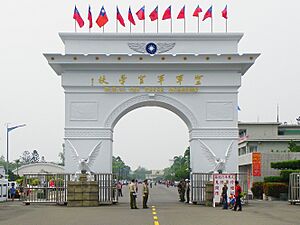Kaohsiung facts for kids
Quick facts for kids
Kaohsiung City
高雄市
Takau, Takow
|
|||
|---|---|---|---|
|
Special municipality
|
|||
|
Kaohsiung skyline
Kaohsiung National Stadium
Kaohsiung Museum of History
Lotus Pond
National Kaohsiung Center for the Arts
Kaohsiung Music Center
|
|||
|
|||
| Etymology: Takao Prefecture | |||
| Nickname(s):
The Harbor City (Gǎngdū), The Maritime Capital, The Waterfront City
|
|||
 |
|||
| Country | |||
| Fongshan County | 1683 | ||
| Takao Prefecture | September 1920 | ||
| Kaohsiung City | 25 October 1945 | ||
| Kaohsiung County | 6 December 1945 | ||
| Upgraded to Yuan-controlled municipality | 1 July 1979 | ||
| Merger with Kaohsiung County | 25 December 2010 | ||
| City seat | Lingya District (mayor's office) Fongshan District (City Council) 22°36′54″N 120°17′51″E / 22.61500°N 120.29750°E |
||
| Districts | 38 | ||
| Largest district | Sanmin District | ||
| Government | |||
|
• Mayor
|
Chen Chi-mai (DPP) | ||
| Legislature | Kaohsiung City Council | ||
| National representation | |||
| 8 of 113 constituencies | |||
| Area | |||
|
• Total
|
2,951.85 km2 (1,139.72 sq mi) (4th) | ||
| Elevation | 9 m (30 ft) | ||
| Population | |||
|
• October 2023 estimate
|
2,737,660 (3rd)
2,565,000 (urban) (3rd) |
||
| GDP (PPP) | 2016 estimate | ||
|
• Total
|
US$45,285 (12th) | ||
| GDP (nominal) | 2016 estimate | ||
|
• Total
|
NT$684,260 (12th) | ||
| Time zone | UTC+8 (National Standard Time) | ||
| Calling code | 07 | ||
| Postal code |
800–852
|
||
| ISO 3166 code | TW-KHH | ||
| Website | |||
| Symbols | |||
| Flower | Chinese hibiscus (Hibiscus rosa-sinensis) | ||
| Tree | Cotton Tree (Bombax ceiba) | ||
| Kaohsiung City | |||||||||||||||||||||||||||||||||||||
|---|---|---|---|---|---|---|---|---|---|---|---|---|---|---|---|---|---|---|---|---|---|---|---|---|---|---|---|---|---|---|---|---|---|---|---|---|---|

"Kaohsiung" in Chinese characters
|
|||||||||||||||||||||||||||||||||||||
| Chinese name | |||||||||||||||||||||||||||||||||||||
| Chinese | 高雄市 | ||||||||||||||||||||||||||||||||||||
| Literal meaning | Japanese transcription of an old Siraya name | ||||||||||||||||||||||||||||||||||||
|
|||||||||||||||||||||||||||||||||||||
| Japanese name | |||||||||||||||||||||||||||||||||||||
| Kanji | 高雄市 | ||||||||||||||||||||||||||||||||||||
| Hiragana | たかおし | ||||||||||||||||||||||||||||||||||||
| Katakana | タカオシ | ||||||||||||||||||||||||||||||||||||
|
|||||||||||||||||||||||||||||||||||||
Kaohsiung is a big city in southern Taiwan. It stretches from the coast all the way to the Yushan Range mountains. Kaohsiung City is home to about 2.73 million people, making it Taiwan's third-largest city. It is also the biggest city in southern Taiwan.
The city started as a small trading village called Takau (or Takow) in the 17th century. Over time, it grew into an important center for business and government in southern Taiwan. Key industries here include making things, steel-making, oil refining, shipping goods, and shipbuilding.
Kaohsiung is very important to Taiwan because it's the country's main port city. The Port of Kaohsiung is the biggest and busiest harbor in Taiwan. More than 67% of Taiwan's goods that are shipped in and out go through this port. Kaohsiung International Airport is also the second busiest airport in Taiwan for passengers. The city is well-connected to other major cities by fast trains and regular trains, as well as highways. It is also where Taiwan's navy has its main base and its naval academy. Recently, places like Pier-2 Art Center, National Kaohsiung Center for the Arts, and Kaohsiung Music Center have been built to help the city's tourism and cultural activities grow.
Contents
- Understanding the Name of Kaohsiung
- Kaohsiung's Past: A Quick Look
- Kaohsiung's Location and Weather
- Who Lives in Kaohsiung?
- Kaohsiung's Economy
- Fun Things to Do in Kaohsiung
- Languages Spoken in Kaohsiung
- Arts and Culture
- Religions in Kaohsiung
- Getting Around Kaohsiung
- Sports in Kaohsiung
- Learning in Kaohsiung
- Conferences and Events
- Sister Cities Around the World
- Images for kids
- See also
Understanding the Name of Kaohsiung
When people from the Hoklo group arrived in this area in the 1500s and 1600s, they called it Takau. The Chinese words used for this name meant "beat the dog."
One idea is that "Takau" came from the original Siraya language spoken by the native people. In their language, it meant "bamboo forest." Another idea is that the name changed from the word for the Makatao tribe, who lived there when Europeans and Hoklo people first settled.
During the time when the Dutch controlled southern Taiwan, Europeans knew the area as Tancoia. In 1662, the Dutch were forced out by Koxinga's son, Zheng Jing. He renamed the village Banlian-chiu in 1664.
The name "Takau" was used again in the late 1670s as the town grew. It stayed that way until Taiwan was given to Japan in 1895. In 1920, the Japanese changed the name to Takao, which sounded similar to the old name in Japanese. This new name was taken from a place in Kyoto, Japan.
After Taiwan was given back to the Republic of China in 1945, the Chinese words for the name stayed the same. But now, they were pronounced in Mandarin Chinese, becoming "Kaohsiung."
The name Takau is still the official name of the city in some native Taiwanese languages, like Rukai. It is also a popular name for local businesses and events.
Kaohsiung's Past: A Quick Look
The written history of Kaohsiung goes back to the early 1600s. However, old findings show that people lived here as far back as 7,000 years ago. Before the 1600s, the Makatao tribe lived in this area. They called their home Takau Isle, which meant "bamboo forest" in their language.
Early Days
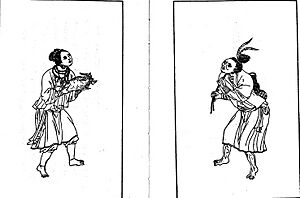
The oldest signs of people in Kaohsiung are from about 4,700 to 5,200 years ago. Most of these old items were found in the hills around Kaohsiung Harbor. These findings suggest that the ancient Kaohsiung Harbor was once a lagoon. Early people here mostly hunted and gathered food. Some farming tools were also found, meaning they also did some farming.
The first Chinese records of this area were written in 1603. A Chinese explorer named Chen Di mentioned "Ta-kau Isle" in his report.
Dutch and Qing Rule
Taiwan became a Dutch colony in 1624. At that time, Takau was already an important fishing port. The Dutch called the place Tankoya. In 1684, the Qing dynasty took control of Taiwan. They renamed the town Fongshan County. It became a port in the 1680s and grew well for many years.
Japanese Rule
In 1895, Taiwan was given to Japan. In 1920, the city was renamed Takao City. The Japanese developed Takao, especially its harbor, which became the base for Kaohsiung to be a port city. They modernized the city and connected it to the main railway line. In the 1930s, Japan planned for Kaohsiung to become a big industrial center. New industries like oil refining, machinery, shipbuilding, and cement making were started.
Before and during World War II, Kaohsiung handled many of Taiwan's farm exports to Japan. It was also a key base for Japan's military actions in Southeast Asia. The city was heavily bombed by American forces between 1944 and 1945.
Republic of China Era
After World War II, Taiwan was given to the Republic of China government in 1945. Kaohsiung City and Kaohsiung County were created. The city's name was officially changed to "Kaohsiung."
Kaohsiung grew very fast during this time. The port, which was damaged in the war, was fixed. It also became a major fishing port. Because of its warm weather, Kaohsiung became Taiwan's main port. In the late 1970s, Kaohsiung became the second-largest city in Taiwan. On July 1, 1979, it was made a special city.
On December 25, 2010, Kaohsiung City joined with Kaohsiung County to form a larger special city. On July 31, 2014, a series of gas explosions happened in the city, causing damage and injuries.
Kaohsiung's Location and Weather

Kaohsiung is on the southwest coast of Taiwan, facing the Taiwan Strait. It borders Tainan City to the northwest and Pingtung County to the south. The city center is around Kaohsiung Harbor. Cijin Island acts like a natural wall protecting the harbor. The Love River flows into the harbor. Important natural spots in Kaohsiung include Ape Hill and Mount Banping.
Climate
Kaohsiung has a warm, tropical savanna climate. This means it has hot, rainy summers and warm, dry winters. The average monthly temperatures are between 20 and 29 degrees Celsius (68 and 84 degrees Fahrenheit). The air is usually quite humid.
Kaohsiung's warm weather is due to its location near the Tropic of Cancer and the warm sea currents. The Central Mountain Range also blocks cool winds in winter. This makes Kaohsiung warmer than other cities at similar latitudes. The average yearly rainfall is about 1885 mm, mostly from June to August. Kaohsiung is one of the sunniest places in Taiwan, with over 2,210 hours of sunshine each year.
| Climate data for Kaohsiung City (1991–2020 normals, extremes 1931–present) | |||||||||||||
|---|---|---|---|---|---|---|---|---|---|---|---|---|---|
| Month | Jan | Feb | Mar | Apr | May | Jun | Jul | Aug | Sep | Oct | Nov | Dec | Year |
| Record high °C (°F) | 31.6 (88.9) |
32.5 (90.5) |
33.2 (91.8) |
35.4 (95.7) |
36.4 (97.5) |
37.2 (99.0) |
37.1 (98.8) |
36.1 (97.0) |
37.6 (99.7) |
34.8 (94.6) |
33.0 (91.4) |
34.4 (93.9) |
37.6 (99.7) |
| Mean daily maximum °C (°F) | 24.2 (75.6) |
25.0 (77.0) |
27.0 (80.6) |
29.3 (84.7) |
31.0 (87.8) |
32.1 (89.8) |
32.7 (90.9) |
32.1 (89.8) |
31.8 (89.2) |
30.1 (86.2) |
28.1 (82.6) |
25.3 (77.5) |
29.1 (84.3) |
| Daily mean °C (°F) | 19.7 (67.5) |
20.7 (69.3) |
23.0 (73.4) |
25.7 (78.3) |
27.8 (82.0) |
28.9 (84.0) |
29.4 (84.9) |
28.9 (84.0) |
28.5 (83.3) |
26.9 (80.4) |
24.5 (76.1) |
21.2 (70.2) |
25.4 (77.8) |
| Mean daily minimum °C (°F) | 16.2 (61.2) |
17.2 (63.0) |
19.7 (67.5) |
22.8 (73.0) |
25.2 (77.4) |
26.3 (79.3) |
26.7 (80.1) |
26.3 (79.3) |
25.9 (78.6) |
24.4 (75.9) |
21.6 (70.9) |
17.9 (64.2) |
22.5 (72.5) |
| Record low °C (°F) | 5.7 (42.3) |
6.6 (43.9) |
6.8 (44.2) |
10.3 (50.5) |
17.3 (63.1) |
19.0 (66.2) |
20.0 (68.0) |
20.7 (69.3) |
19.5 (67.1) |
14.7 (58.5) |
10.2 (50.4) |
4.4 (39.9) |
4.4 (39.9) |
| Average precipitation mm (inches) | 19.1 (0.75) |
17.7 (0.70) |
32.3 (1.27) |
68.4 (2.69) |
202.2 (7.96) |
416.2 (16.39) |
377.2 (14.85) |
512.4 (20.17) |
224.5 (8.84) |
53.4 (2.10) |
25.6 (1.01) |
19.2 (0.76) |
1,968.2 (77.49) |
| Average precipitation days (≥ 0.1 mm) | 3.2 | 3.2 | 3.6 | 5.4 | 6.2 | 12.9 | 13.2 | 16.7 | 10.1 | 4.2 | 2.8 | 2.8 | 84.3 |
| Average relative humidity (%) | 71.6 | 71.8 | 71.9 | 74.2 | 76.6 | 79.0 | 78.0 | 79.9 | 77.5 | 74.2 | 73.1 | 71.6 | 75.0 |
| Mean monthly sunshine hours | 177.0 | 176.0 | 194.7 | 197.2 | 207.7 | 215.0 | 220.7 | 189.3 | 188.6 | 191.9 | 166.5 | 157.2 | 2,281.8 |
| Source: Central Weather Bureau | |||||||||||||
| Climate data for Kaohsiung International Airport (2010–2014 Temperatures) | |||||||||||||
|---|---|---|---|---|---|---|---|---|---|---|---|---|---|
| Month | Jan | Feb | Mar | Apr | May | Jun | Jul | Aug | Sep | Oct | Nov | Dec | Year |
| Record high °C (°F) | 30 (86) |
32 (90) |
33 (91) |
34 (93) |
35 (95) |
36 (97) |
36 (97) |
35 (95) |
37 (99) |
33 (91) |
33 (91) |
32 (90) |
37 (99) |
| Mean daily maximum °C (°F) | 25.0 (77.0) |
26.6 (79.9) |
28.0 (82.4) |
29.2 (84.6) |
31.0 (87.8) |
32.0 (89.6) |
32.6 (90.7) |
32.0 (89.6) |
32.0 (89.6) |
30.2 (86.4) |
28.6 (83.5) |
25.0 (77.0) |
29.4 (84.8) |
| Daily mean °C (°F) | 19.8 (67.6) |
21.4 (70.5) |
23.6 (74.5) |
25.4 (77.7) |
27.6 (81.7) |
28.8 (83.8) |
29.2 (84.6) |
28.5 (83.3) |
28.0 (82.4) |
26.4 (79.5) |
24.6 (76.3) |
20.6 (69.1) |
25.3 (77.6) |
| Mean daily minimum °C (°F) | 15.4 (59.7) |
17.2 (63.0) |
19.6 (67.3) |
23.2 (73.8) |
24.8 (76.6) |
26.4 (79.5) |
26.4 (79.5) |
25.5 (77.9) |
25.0 (77.0) |
23.4 (74.1) |
21.2 (70.2) |
16.8 (62.2) |
22.1 (71.7) |
| Record low °C (°F) | 9 (48) |
12 (54) |
13 (55) |
14 (57) |
20 (68) |
22 (72) |
24 (75) |
23 (73) |
22 (72) |
18 (64) |
13 (55) |
10 (50) |
9 (48) |
| Source: Wunderground | |||||||||||||
City Views
Who Lives in Kaohsiung?
| Historical population | ||
|---|---|---|
| Year | Pop. | ±% |
| 1985 | 2,379,610 | — |
| 1990 | 2,505,986 | +5.3% |
| 1995 | 2,619,947 | +4.5% |
| 2000 | 2,725,267 | +4.0% |
| 2005 | 2,760,180 | +1.3% |
| 2010 | 2,773,483 | +0.5% |
| 2015 | 2,778,918 | +0.2% |
| 2020 | 2,765,932 | −0.5% |
| Source: | ||
As of December 2018, Kaohsiung City had about 2.77 million people. This makes it the third-largest city in Taiwan. The most crowded area is Sinsing District.
Different Groups of People
Han Chinese
Most people in Kaohsiung are Han Chinese. This group is divided into three main parts: Hoklo, Hakka, and Waishengren. The Hoklo and Waishengren mostly live in the city center and flat areas. Most Hakka people live in the suburbs or rural areas in the northeastern hills.
Indigenous Peoples
The native peoples of Kaohsiung belong to different groups. They speak languages from the Austronesian family. Most of them live in the mountain districts like Taoyuan or Namasia. The main native groups here are the Bunun, Rukai, Saaroa, and Kanakanavu.
Other People
Kaohsiung is also home to many people from other countries. This includes foreign spouses and workers. Many foreign workers come from Indonesia, Vietnam, the Philippines, or Thailand.
Kaohsiung's Economy
Kaohsiung is a major international port and industrial city in southwest Taiwan. It helps move goods for the farms in southern Taiwan and the mountains in the southeast. Important things shipped out include rice, sugar, bananas, and pineapples.
The Linhai Industrial Park is a large area by the water. It has a steel mill, a shipyard, and other factories. The city also has an oil refinery, factories for aluminum and cement, and places that make paper. Kaohsiung also attracted foreign businesses to process local materials for export.
In 2020, a big land project in the Port of Kaohsiung was finished. This new land is planned to become a solar energy industrial area.
Kaohsiung's total economic output is about US$45 billion. The city wants to grow its tourism and cultural industries. Projects like Pier-2 Art Center and National Kaohsiung Center for the Arts are helping with this.
Farming in Kaohsiung
The main farm products in Kaohsiung are vegetables, fruits, and rice. About 16% of the city's land is used for farming. Kaohsiung grows the most guava, jujube, and lychee in Taiwan. Farmers also raise chickens, dairy cows, pigs, and other animals. The total yearly income from farming in Kaohsiung is NT$24.15 billion.
Fun Things to Do in Kaohsiung
Kaohsiung has many interesting places to visit. Some famous landmarks include the 85 Sky Tower, the Ferris wheel at Dream Mall, and the Kaohsiung Arena. The city is also known for its many shopping streets, lively night markets, and new parks like the Pier-2 Art Center and E-DA Theme Park.
Nature Spots
Kaohsiung has many natural attractions because it is a large city with different types of land. It has mountains in the northeast and the warm South China Sea to the west. The warm weather allows coral reefs to grow along the coast. Shoushan Mountain is even made entirely of coral reefs! The city also includes parts of Yushan National Park, which has Taiwan's highest mountain, Yushan. Other cool nature spots are Mount Banping and Lotus Pond.
Historical Places
Kaohsiung has many historical sites from different times. These include places from the Dutch, Qing dynasty, and Japanese periods. The city government has worked to protect these sites. Many are now open for people to visit. Famous historical sites include the Old City of Zuoying, the Former British Consulate at Takao, and the Kaohsiung Lighthouse.
Museums to Explore
Kaohsiung has many museums. You can learn about history at the Kaohsiung Museum of History, or about science at the National Science and Technology Museum. There are also museums about specific topics like shells, fossils, sugar, and pineapples.
Parks and Zoos
Kaohsiung has many parks and fun areas. Some popular parks include Central Park and Siaogangshan Skywalk Park. You can also visit the Fo Guang Shan Monastery and see the Dragon and Tiger Pagodas. For animals, there is the Kaohsiung City Shousan Zoo.
Other Attractions
Kaohsiung is famous for its many night markets, such as Liuhe Night Market and Ruifeng Night Market. Here, you can find lots of delicious food and things to buy. Other interesting places include the Cijin Tianhou Temple and the beautiful "Dome of Light" at the Formosa Boulevard Station of the Kaohsiung MRT.
Languages Spoken in Kaohsiung
Most people in Kaohsiung can speak both Taiwanese Hokkien and Mandarin. Some older people who grew up when Japan ruled Taiwan can speak Japanese. Many younger people know some English.
After the Chinese Civil War, Mandarin became more common. Because of this, Hakka Chinese and many native Taiwanese languages are spoken less by younger generations. The government has groups to help protect the languages and cultures of native peoples and Hakka people.
Arts and Culture
The "Dome of Light" at Formosa Boulevard Station is one of the world's largest public glass works of art. Kaohsiung also has the Urban Spotlight Arcade, a street with many art displays. The National Kaohsiung Center for the Arts (Weiwuying) opened in 2018. It is known as the largest performing arts center under one roof in the world.
Religions in Kaohsiung
Religion in Taiwan (Government statistics, 2005) Buddhism (35.1%) Taoism (33%) Christianity (3.9%) Yiguandao (3.5%) Tiandism (2.2%) Miledadao (1.1%) Zailiism (0.8%) Other or undeclared (2.4%) Non-religious (18.7%)
The main religions in Kaohsiung are Buddhism, Taoism, Islam, and Christianity. As of 2015, Kaohsiung City has 1,481 temples, which is the second highest number in Taiwan. It also has 306 churches.
Buddhism
Buddhism is a major religion in Taiwan. Kaohsiung is home to the largest Buddhist temple in Taiwan, the Fo Guang Shan Monastery, which includes the Fo Guang Shan Buddha Museum. Other famous Buddhist temples are Fengshan Longshan Temple.
Taoism
Taoism is another big religion in Taiwan. Many people who believe in Taoism also follow Buddhism. The differences between the two religions are not always clear. Many people in Kaohsiung also worship the sea goddess Mazu. Her temple on Cijin Island, Chi Jin Mazu Temple, is the oldest in the city, built in 1673.
Christianity
Christianity is a smaller religion in Taiwan. It first came to the island in the 1600s with the Dutch and Spanish. Kaohsiung currently has about 56,000 Christians.
Islam
Kaohsiung has a small but growing number of Muslims. Many Muslims came to Taiwan after the Chinese Civil War. More recently, many Indonesian workers have moved to Taiwan, increasing the Muslim population. The Kaohsiung Mosque is the largest mosque in the city and a main meeting place for Muslims.
Getting Around Kaohsiung
Kaohsiung Port
Kaohsiung has a very important port. Most of Taiwan's goods that come in and go out by sea pass through here. The Port of Kaohsiung is Taiwan's largest container port. It is also the 13th largest in the world. Ferries are an important way to travel across the harbor.
Kaohsiung International Airport
Kaohsiung City also has Taiwan's second-largest international airport, the Kaohsiung International Airport. It serves passengers from southern and southeastern Taiwan. The airport is planning to build a new terminal starting in 2023. This will allow it to handle up to 16.5 million passengers.
Rapid Transit System
The Kaohsiung Mass Rapid Transit (MRT) system started in March 2008. It has two lines and 37 stations. Two of Kaohsiung's MRT stations, Formosa Boulevard Station and Central Park Station, are considered among the most beautiful subway stations in the world.
Circular Light Rail
The Circular Light Rail Line (also called Kaohsiung LRT or Kaohsiung Tram) is a light rail line in the city. It started running fully in September 2017. To help with air pollution, riding the light rail and buses is free for electronic ticket holders during winter months.
Trains
The city has train services provided by the Taiwan Railways Administration. Kaohsiung Main Station is an underground station.
High Speed Rail
Since 2007, the Taiwan High Speed Rail has served Kaohsiung through Zuoying HSR station. In 2023, plans were approved to extend the High Speed Rail.
Sports in Kaohsiung
Kaohsiung is home to Taiwan's largest international stadium, the National Stadium. It can hold up to 55,000 people. The city also has the Kaohsiung Arena. Kaohsiung hosted the 2009 World Games at the National Stadium. Almost 6,000 athletes and officials from 103 countries took part.
Taiwan's professional baseball team, TSG Hawks, is based in Kaohsiung. The city also has two professional basketball teams: the Kaohsiung Aquas and the Kaohsiung 17LIVE Steelers.
Other major sports events held in Kaohsiung include:
- 2001 Asian Cycling Championships
- 2005 WPA World Nine-ball Championship
- 2011 AFC President's Cup
- 2013 World Modern Pentathlon Championships
- 2016 Asian Men's U20 Volleyball Championship
- WTA Taiwan Open (2016)
- 2019 U-19 Asia Rugby Championship
- Kaohsiung Fubon Marathon (held every year)
Learning in Kaohsiung

Kaohsiung has many colleges and universities. They offer training in business, education, sea technology, medicine, languages, nursing, and other fields. There are also several international schools and eight national military schools. These include the three main military academies of Taiwan: the Republic of China Military Academy, Republic of China Naval Academy, and Republic of China Air Force Academy.
Universities
- I-Shou University
- Kaohsiung Medical University
- National Kaohsiung Normal University
- National Sun Yat-sen University
- National University of Kaohsiung
Technical and Vocational Universities
- Cheng Shiu University
- Fooyin University
- National Kaohsiung University of Hospitality and Tourism
- National Kaohsiung University of Science and Technology
- Wenzao Ursuline University of Languages
High Schools and Junior High Schools
- The Affiliated Hospitality Senior High School of National Kaohsiung University of Hospitality and Tourism
- The Affiliated Senior High School of National Kaohsiung Normal University
- Cheng Yi Senior High School
- Chung Cheng Armed Forces Preparatory School
- Chung Shan Industrial & Commercial School
- Chung-Hwa School of Arts
- FUHWA Senior High School
- Guoguang Laboratory School, National Sun Yat-sen University
- Kao-Feng Vocational High School
- Kaohsiung Dah Yung Senior High School
- Kaohsiung Municipal Chung-Cheng Industrial High School
- Kaohsiung Municipal Chungshan Senior High School
- Kaohsiung Municipal Cianjhen Senior High School
- Kaohsiung Municipal Fu Cheng High School
- Kaohsiung Municipal Gushan Senior High School
- Kaohsiung Municipal Haiching Vocational High School of Technology and Commerce
- Kaohsiung Municipal Jhongjheng Senior High School
- Kaohsiung Municipal Kaohsiung Girls' Senior High School
- Kaohsiung Municipal Kaohsiung Industrial High School
- Kaohsiung Municipal Kaohsiung Senior High School
- Kaohsiung Municipal Kaohsiung Vocational High School of Commerce
- Kaohsiung Municipal Lujhu Senior High School
- Kaohsiung Municipal Nanzih Comprehensive Senior High School
- Kaohsiung Municipal Renwu Senior High School
- Kaohsiung Municipal Rueisiang High School
- Kaohsiung Municipal Sanmin Home Economics & Commerce Vocational High School
- Kaohsiung Municipal Sanmin Senior High School
- Kaohsiung Municipal Siaogang Senior High School
- Kaohsiung Municipal Sinsing Senior High School
- Kaohsiung Municipal Tsoying Senior High School
- Kaohsiung MunicipalHsin Chuang Senior High School
- Lichih Senior High School
- National Feng-Hsin Senior High School
- National Feng-Shan Senior High School
- National FongShan Senior Commercial & Industrial Vocational School
- National Kangshan Agricultural & Industrial Vocational Senior High School
- National Kangshan Senior High School
- Saint Dominic's Catholic High School
- Sansin High School of Commerce And Home Economics Kaohsiung
- Shu-Te Home economics&Commercial High School
- Sin-Guang Senior High School
- Taiwan Kaohsiung St. Paul's High School
International Schools
- Dominican International School Kaohsiung
- I-Shou International School
- Kaohsiung American School
- Kivam Junior High School
- Morrison Academy Kaohsiung
Military Schools
- Chung Cheng Armed Forces Preparatory School
- Republic of China Air Force Academy
- Republic of China Air Force Institute of Technology
- Republic of China Army Infantry School
- Republic of China Marine Corps School
- Republic of China Military Academy
- Republic of China Naval Academy
Conferences and Events
The Kaohsiung Exhibition Center opened in April 2014. It has a large space for exhibitions and a hall for conventions. It hosted the Taiwan International Boat Show in May 2014. Another place for events is the International Convention Center Kaohsiung.
Sister Cities Around the World
Kaohsiung has special partnerships with many cities around the world. These are called "sister cities" or "twin towns." They work together on cultural and economic projects.
 Barranquilla, Colombia
Barranquilla, Colombia Belize City, Belize
Belize City, Belize Brisbane, Queensland, Australia
Brisbane, Queensland, Australia Blantyre, Malawi
Blantyre, Malawi Busan, South Korea
Busan, South Korea Cartago, Costa Rica
Cartago, Costa Rica Cebu, Central Visayas, Philippines
Cebu, Central Visayas, Philippines Colorado Springs, Colorado, United States
Colorado Springs, Colorado, United States Da Nang, Vietnam
Da Nang, Vietnam Dipolog, Zamboanga Peninsula, Philippines
Dipolog, Zamboanga Peninsula, Philippines Durban, South Africa
Durban, South Africa Erzgebirgskreis, Saxony, Germany
Erzgebirgskreis, Saxony, Germany George Town, Penang, Malaysia
George Town, Penang, Malaysia Hachiōji, Tokyo, Japan
Hachiōji, Tokyo, Japan Honolulu, Hawaii, United States
Honolulu, Hawaii, United States Knoxville, Tennessee, United States
Knoxville, Tennessee, United States Kumamoto, Kumamoto, Japan
Kumamoto, Kumamoto, Japan Little Rock, Arkansas, United States
Little Rock, Arkansas, United States Macon, Georgia, United States
Macon, Georgia, United States Malé, Maldives
Malé, Maldives Matsumoto, Nagano, Japan
Matsumoto, Nagano, Japan Miami, Florida, United States
Miami, Florida, United States Mobile, Alabama, United States
Mobile, Alabama, United States Monterrey, Nuevo León, Mexico
Monterrey, Nuevo León, Mexico Panama City, Panama
Panama City, Panama Pensacola, Florida, United States
Pensacola, Florida, United States Plains, Georgia, United States
Plains, Georgia, United States Portland, Oregon, United States
Portland, Oregon, United States Rio de Janeiro, Brazil
Rio de Janeiro, Brazil Saint Petersburg, Russia
Saint Petersburg, Russia San Antonio, Texas, United States
San Antonio, Texas, United States San Diego, California, United States
San Diego, California, United States Seattle, Washington, United States
Seattle, Washington, United States Surabaya, East Java, Indonesia
Surabaya, East Java, Indonesia Tijuana, Baja California, Mexico
Tijuana, Baja California, Mexico Tulsa, Oklahoma, United States
Tulsa, Oklahoma, United States Pristina, Kosovo
Pristina, Kosovo
Images for kids
See also
 In Spanish: Kaohsiung para niños
In Spanish: Kaohsiung para niños


